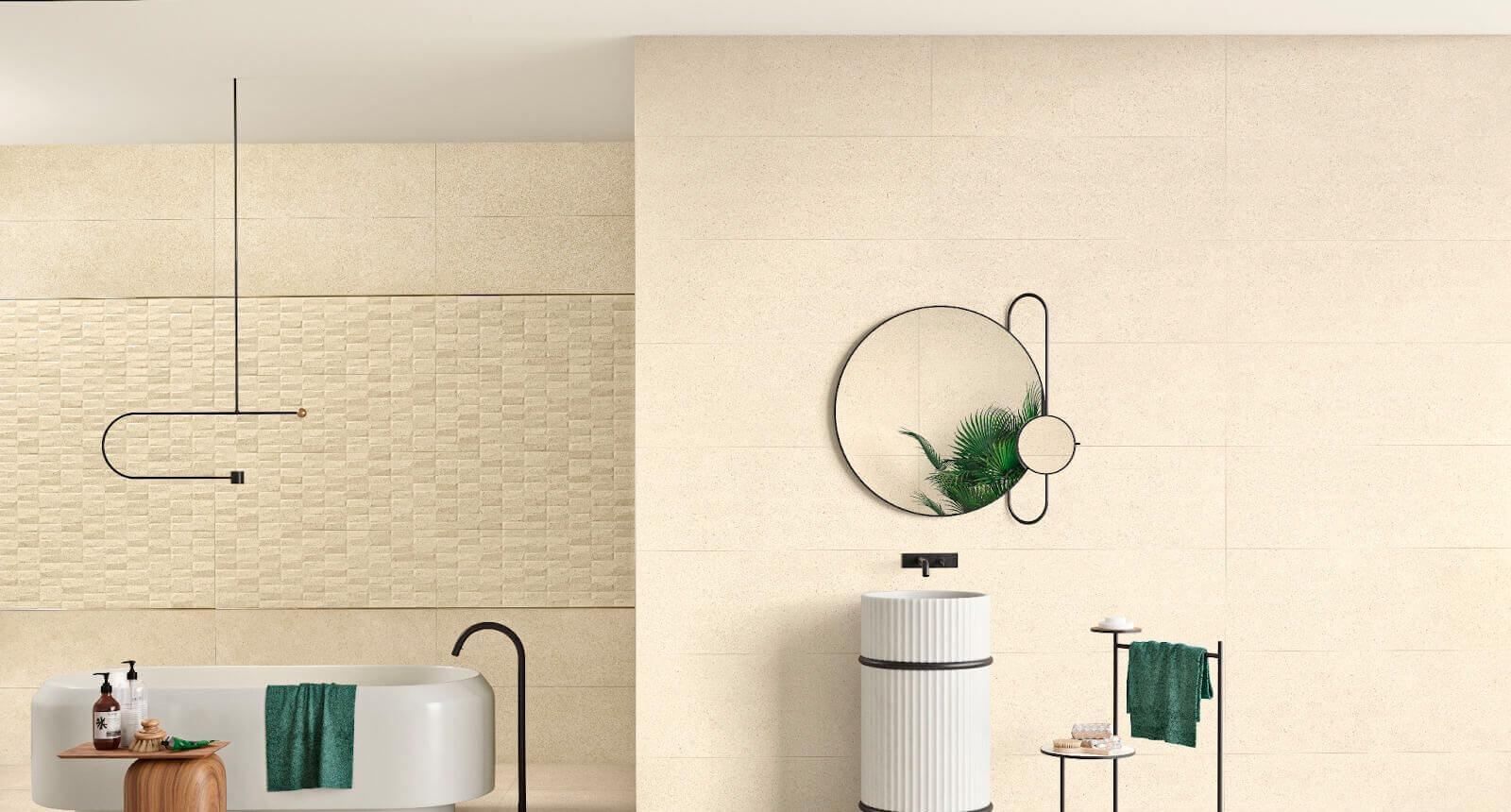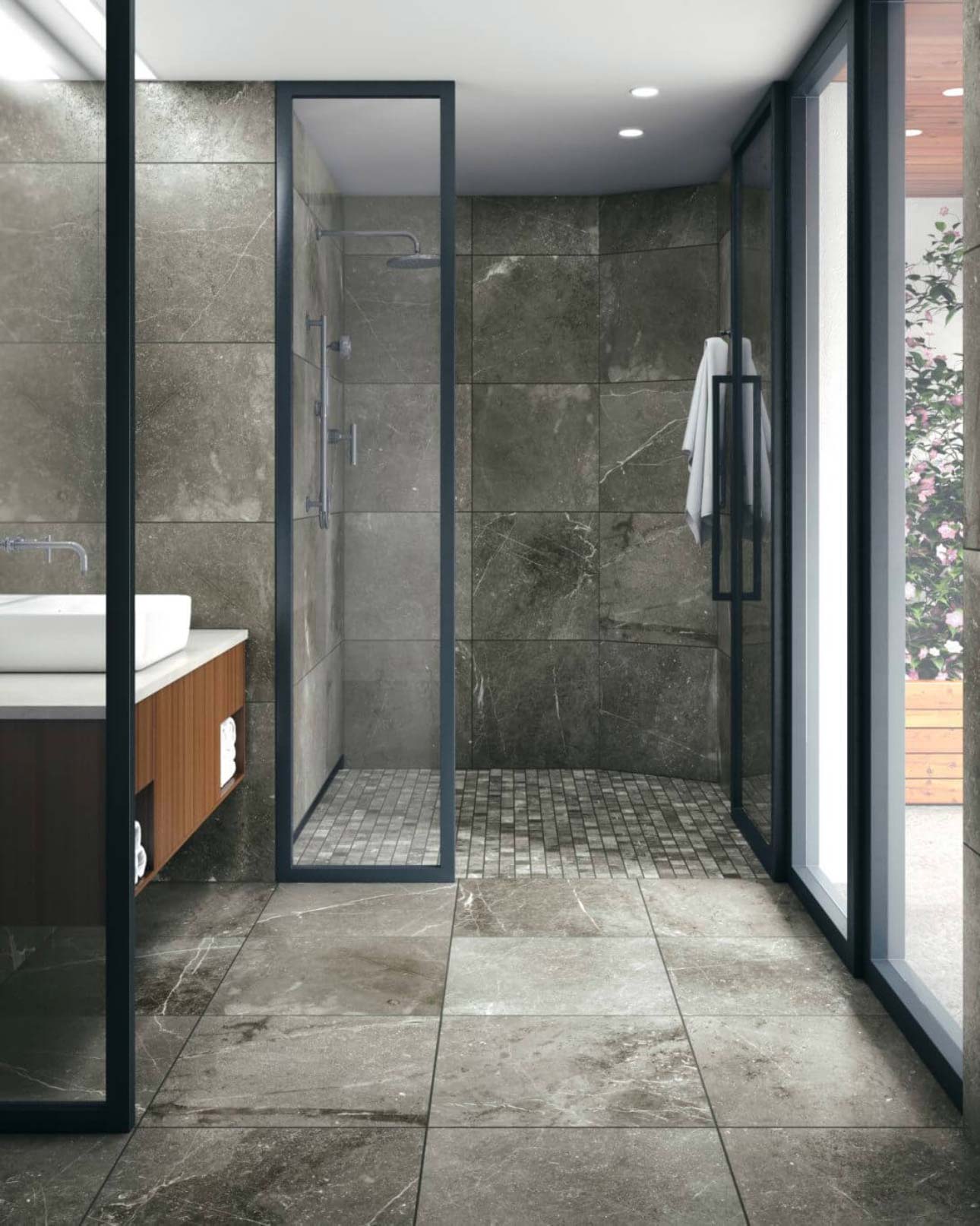What Is the Average Size of a Tile?
When it comes to size, tile knows no limits: Tiles come in sizes ranging from mosaic tiles measuring less than nine inches squared to expansive gauged porcelain panels/slabs.
That means no standard size of a tile exists, although specific ceramic tile sizes have trended over the years. In general, tiles have gotten bigger over time, with the largest options now measuring up to 10 by 15 feet.
How Tile Size Can Influence Your Space
When it comes to tiles, size matters. That’s not to say that bigger is better, but simply that the size of tile you choose will affect your installation and even the perception of your entire room.
Here are a few examples to illustrate this point:
- Larger sizes of tiles can make your space feel bigger because the items in the room will seem farther apart. The fewer grout lines can also help create a more minimalistic look.
- Smaller-size tiles can make expansive spaces feel cozier and add visual interest.
- Long tiles can help elongate spaces or draw the eye toward a focal point.
- Large tiles may not work in small spaces if you want to show off a tile layout. (There may not be enough room to make your desired impact.)
- Very small tiles (mosaic tiles) can allow you to create intricate designs even in small spaces, such as backsplashes. Additionally, the numerous grout joints resulting from mosaic tile installations can provide added friction when you use them for flooring in water-prone areas, such as showers and pool surrounds.
A Note on Mixing Tile Sizes
It’s also important to keep in mind that you don’t need to choose a single size of tiles. In fact, sometimes a good option is to mix tile sizes.
For example, imagine you want to use a stone look for your bathroom. Rather than using the same tile size throughout, mixing tile sizes can add visual interest to your design. You might use mosaic tile for the shower and backsplash and larger tile for the flooring and walls — with the same surface style to tie it all together.
You can also mix tiles’ sizes within the same installation to create a specific layout. For instance, the hopscotch tile pattern is a combination of large and small squares.
Tile Sizes by Look
Let’s review some common tile sizes (in inches) for some of the most popular tile looks.
Square Tile Sizes
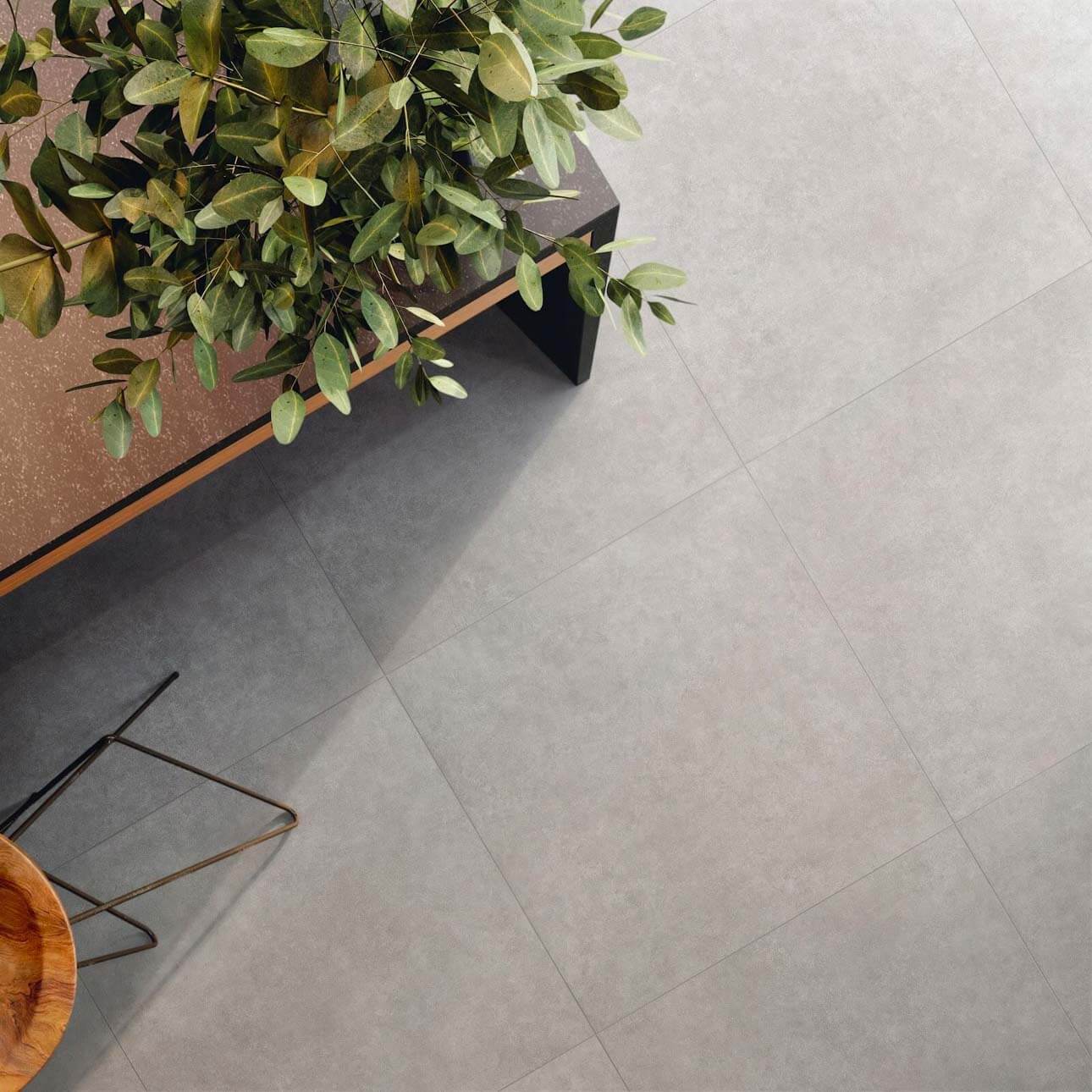
An incredibly versatile option, square tile comes in a large range of sizes.
Square tile is probably the most common tile shape because of its versatility and ease of installation. You can use square tiles to show off a unique pattern or natural look, install them diagonally or with borders, or mix tile sizes and shapes. Actually, just about anything is possible with square tiles.
- 2 by 2 inches
- 6 by 6 inches
- 8 by 8 inches
- 3 by 3 inches
- 12 by 12 inches
- 16 by 16 inches
- 4 by 4 inches
- 18 by 18 inches
- 24 by 24 inches
Rectangle Tile Sizes
Rectangle tiles are also incredibly popular. They’re often the tile shape of choice for these purposes:
- Showing off natural looks, such as stone and wood
- Accomplishing tile layouts, such as subway tile or herringbone tile
- Vertically or horizontally elongating a space
Of course, standard tile sizes vary depending on what look you’re trying to achieve with your rectangle tiles. However, the following options are a good place to start:
- 1 by 2, 3 and 4 inches
- 2 by 3, 4, 5, 6 and 8 inches
- 3 by 4, 5, 6 and 8 inches
- 4 by 4.5, 5, 6 and 8 inches
- 5 by 6 and 8 inches
- 6 by 8 inches
- 12 by 24 inches
- 24 by 36 inches
- 24 by 48 inches
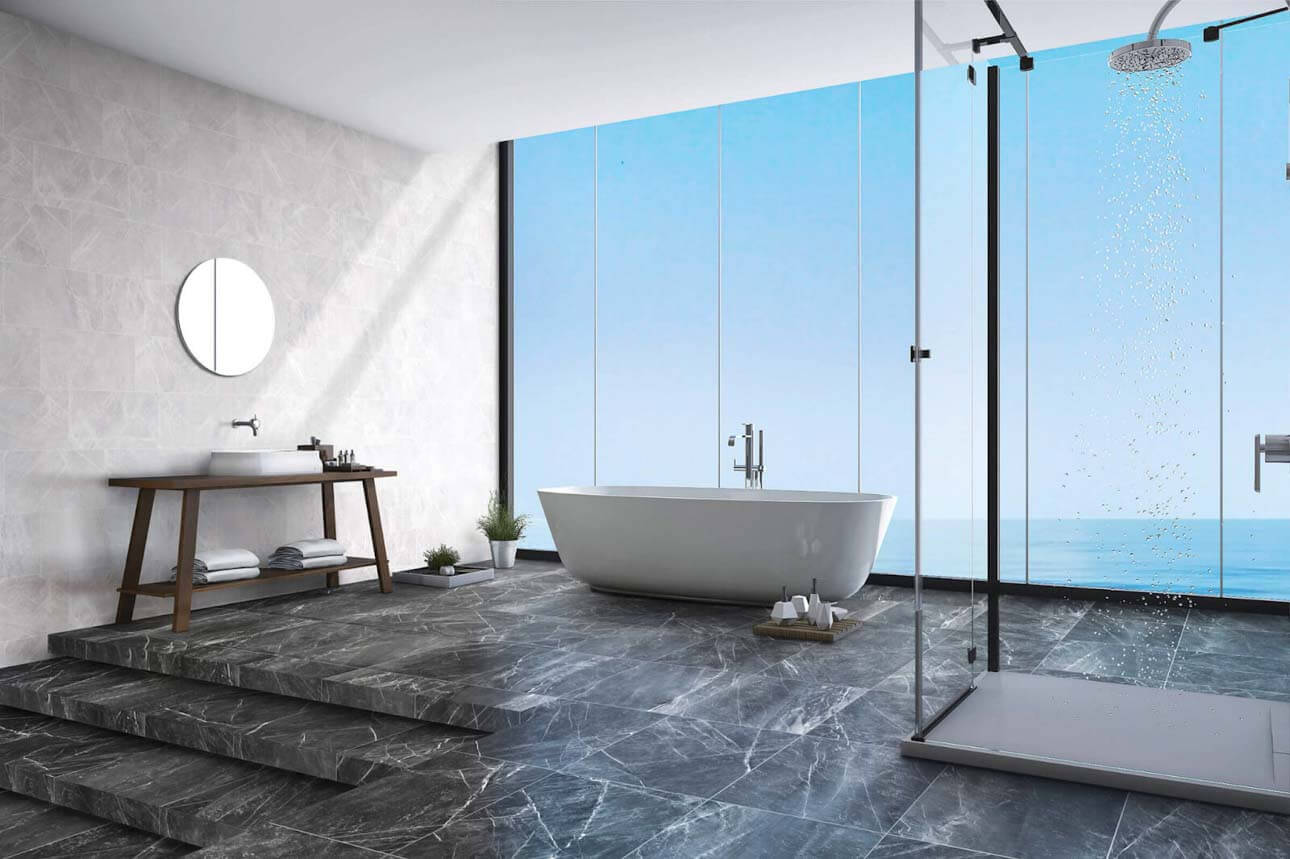
Subway Tile Sizes
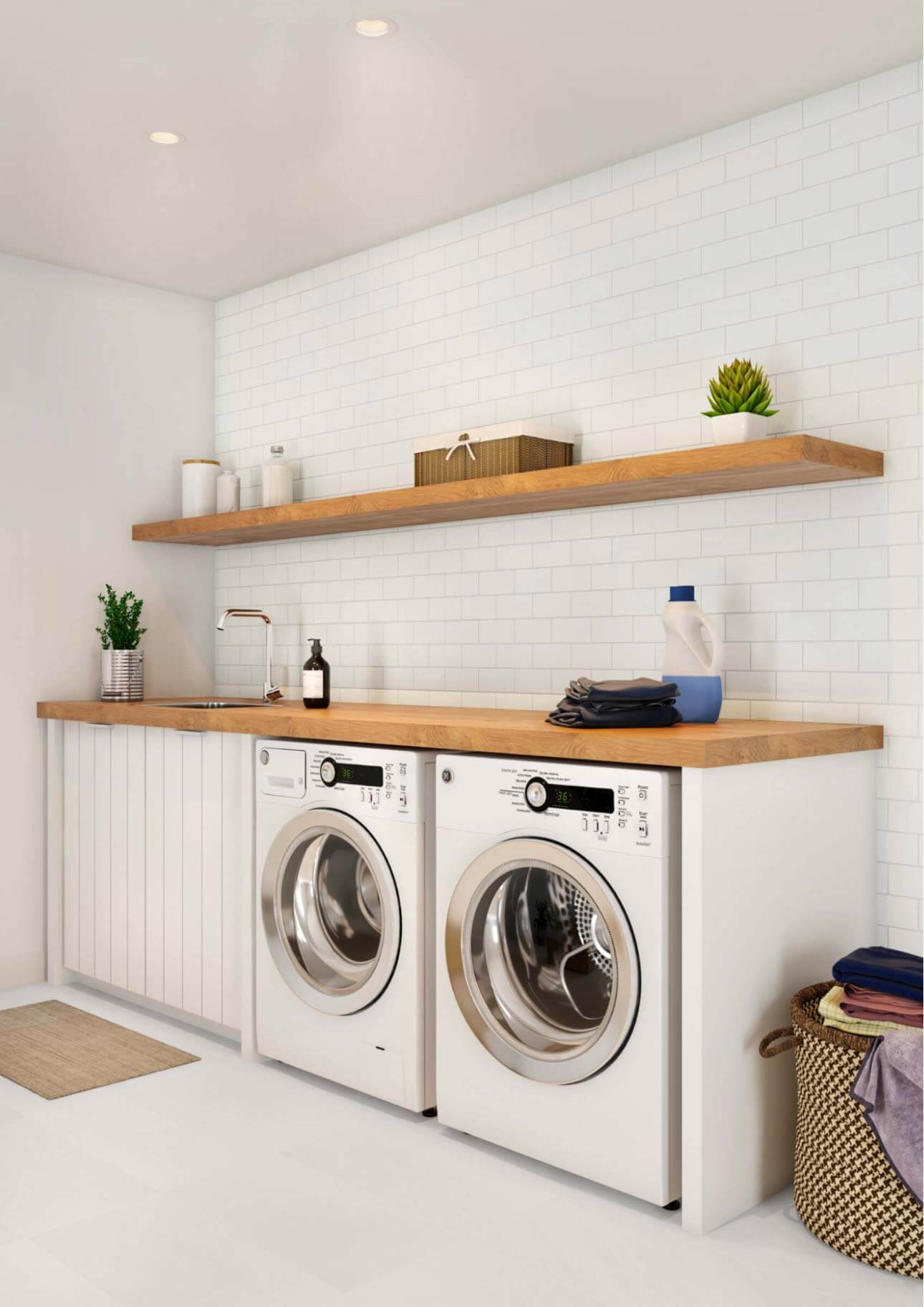
Although technically rectangle tiles, subway tiles are so popular that they still warrant their own tile size chart.
The most common size of a subway tile is 3 by 6 inches. However, just as there are many creative ways to install subway tile, there’s also leeway in terms of subway tile size.
When it comes to subway tiles, sizes include the following:
- 1 by 3, 4 and 6 inches
- 2 by 4, 6, 8 and 12 inches
- 3 by 4, 6, 8 and 12 inches
- 4 by 8, 12 and 16 inches
- 6 by 8 inches
Plank Tile Sizes
Another subset of rectangle tiles includes planks, which are long, skinny tiles that lend themselves to wood looks. As such, you’ll often see people use plank tiles for flooring (although we’ve seen some impressive plank tile on walls as well).
Tile plank sizes range from 4 by 12 to 16 by 32 inches:
- 4 by 12, 24 and 48 inches
- 6 by 24, 36 and 48 inches
- 7 by 20 inches
- 8 by 32, 36 and 48 inches

Hexagon Tile Sizes
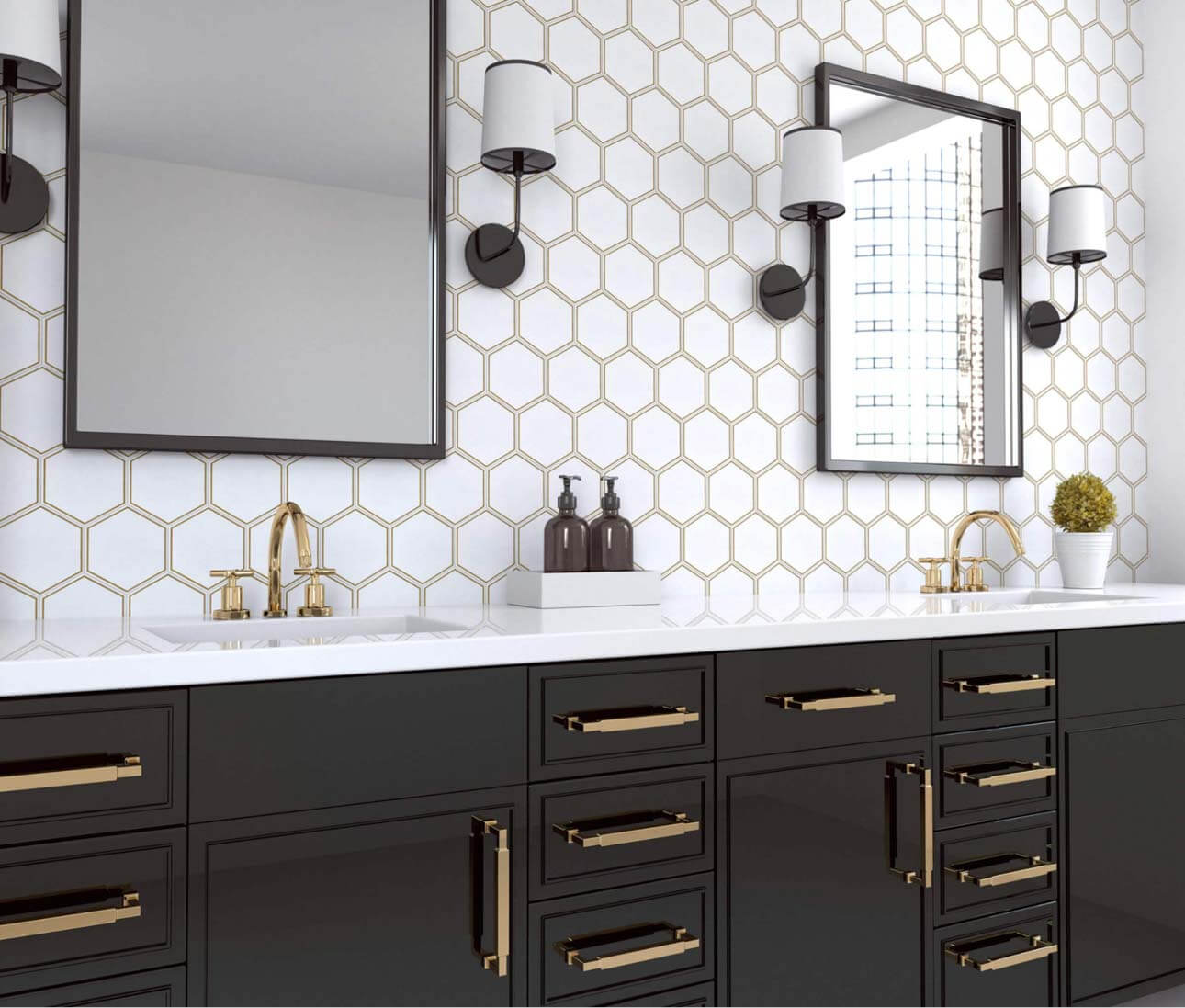
Hexagon tiles range from vintage mosaics to larger modern options.
Hexagon tile is a favorite for anyone who’s looking for a vintage or playful look. Choose from options ranging from 2 inches to 24 inches:
- 2 inches
- 3 inches
- 4 inches
- 6 inches
- 8 inches
- 12 inches
- 16 inches
- 18 inches
- 24 inches
Keep in mind that hexagon tile size makes a big difference. (We know we’ve said this before, but it’s especially true with hex tile.)
For example, small hexagon floor tile sizes — like those measuring 2 or 3 inches — are undeniably retro. Meanwhile, larger hex tile sizes feel much more contemporary.
A Note on How To Measure Hexagon Tile
There are two ways to measure hexagon tiles: from side to side and from point to point. Because methods vary among manufacturers, it’s important to check with your tile distributor to ensure you accurately understand the tiles’ size.
Mosaic Tile Sizes
Mosaic tiles’ defining characteristic is their size. Their smallness lends itself to creative combinations with multiple colors, patterns and textures and makes them perfect for highlighting small focal points, such as backsplashes.
The standard mosaic tile size is typically less than 9 inches squared, or 3 inches or less on each side. To ease the installation, mosaic tiles are usually available mounted in groups on sheets.
Common tile sizes for mosaic tiles include the following:
- 0.25 by 0.25 inch
- 0.5 by 0.5 inch
- 1 by 1 inch
- 2 by 2 inches
- 3 by 3 inches
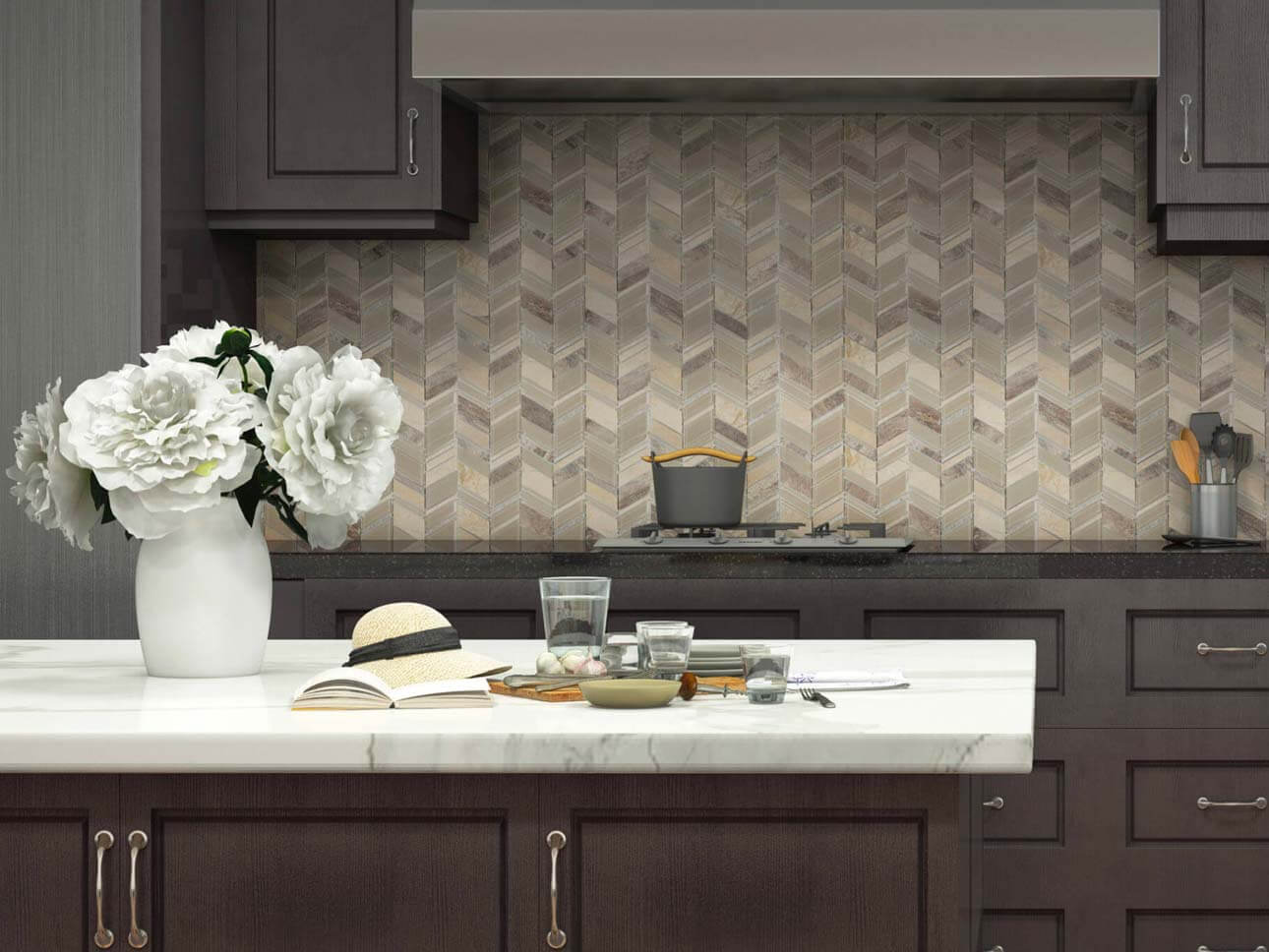
Tiles smaller than 9 inches squared are considered mosaic tiles.
Gauged Porcelain Tile Sizes

The largest tiles available, gauged porcelain tile panels/slabs reach up to 10 by 15 feet.
For the most part, porcelain and ceramic tile sizes are the same — with the exception of gauged porcelain tile.
Gauged porcelain tiles now represent the largest tile size available, effectively throwing any notion of “standard tile size” out the window. There are two subsets of gauged porcelain — gauged porcelain tiles and gauged porcelain tile panels/slabs. Each subset has its own size distinctions:
- Gauged porcelain tiles measure up to 3 by 3 feet (about 1 by 1 meter).
- Gauged porcelain tile panels/slabs are equal to or larger than 3 by 3 feet, with options as large as 10 by 15 feet.
So, if you’re looking for the absolute biggest tile size available, ask for gauged porcelain tile panels measuring 10 by 15 feet. These are great options for covering an entire wall, achieving a natural stone slab look for countertops, and creating a minimalist effect.
Tile Sizes by Application
When it comes to tile sizes, standard options also vary depending on the intended application. Standard floor tile sizes differ from the size of ceiling tiles, wall tiles, and backsplash tiles.
Floor Tile Sizes
What is the size of a floor tile? Like with all tile, floor tile size varies widely.
Options such as 12 by 12, 12 by 24, and 18 by 18 inches are popular for smaller kitchens and living areas. More spacious areas may benefit from 24 by 48, 36 by 36, and 48 by 48 inches. And as we mentioned above, plank tile in sizes ranging from 4 by 12 to 16 by 32 inches is a classic choice for creating a hardwood floor look.
Mosaic tile (measuring less than 9 inches squared) is a great choice for small floor spaces, such as bathroom and shower floors. Mosaic tiles’ smaller size does more than let you show off more of your design in smaller areas — the numerous grout joints resulting from their installation can also contribute to increased texture and slip resistance.
And of course, you can use gauged porcelain tile measuring up to 10 by 15 feet for flooring to create a minimalist effect.
A Note on Floor Tile Size vs. Room Size
Often, we assume smaller rooms warrant smaller tiles and larger rooms warrant larger tiles.
It’s true that smaller rooms may not provide enough floor space to show off a specific tile layout pattern if you go with large tiles. And similarly, very small tiles can feel overwhelming in a spacious room.
Nevertheless, large tiles can actually make small rooms feel more spacious. The fact that their grout lines are more spaced makes items in the room feel farther apart and creates the appearance of more area.
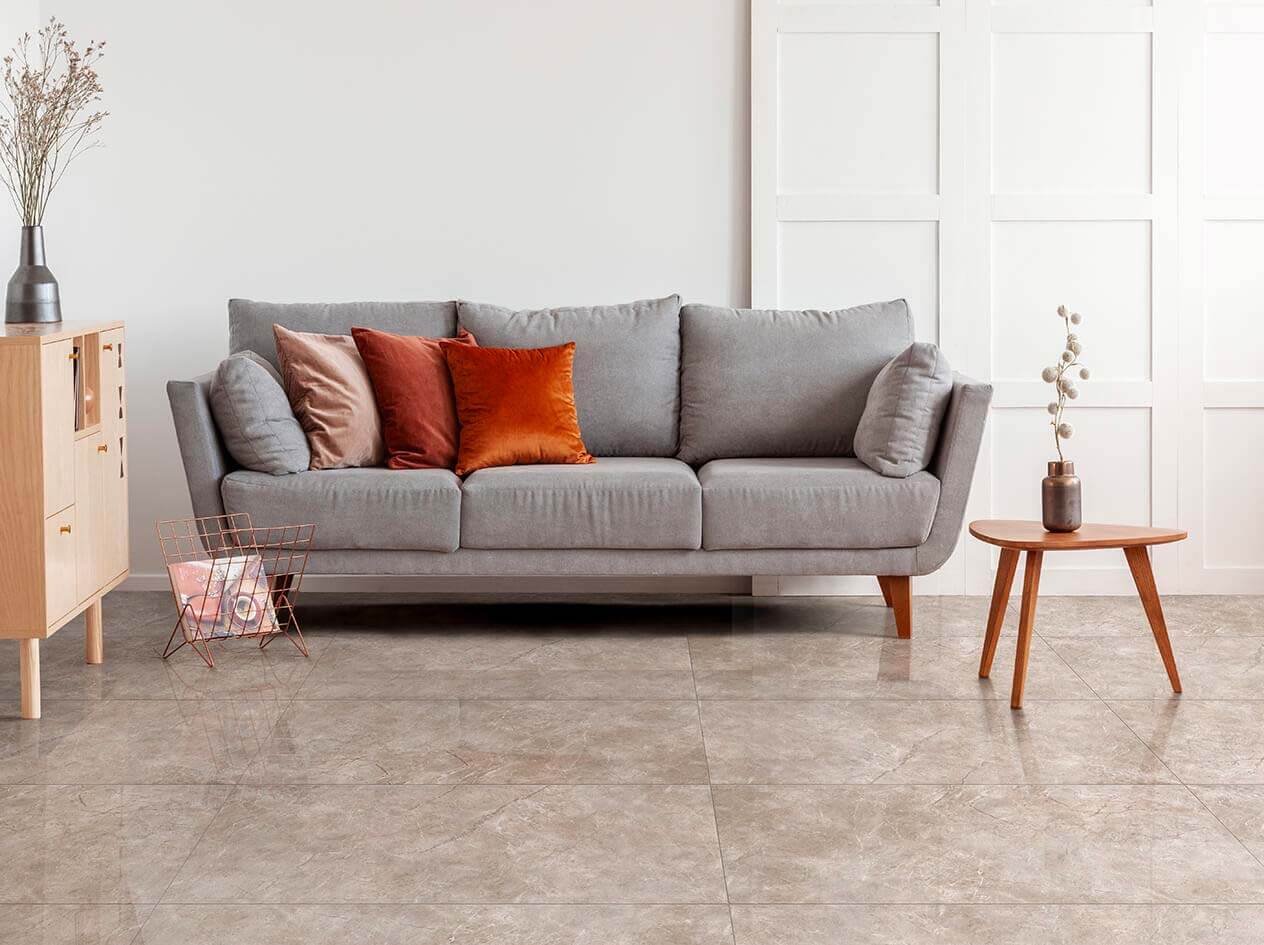
Just about any size of tile works for floor tile as long as it is suitable for flooring applications.
Wall Tile Sizes and Backsplash Tile Sizes
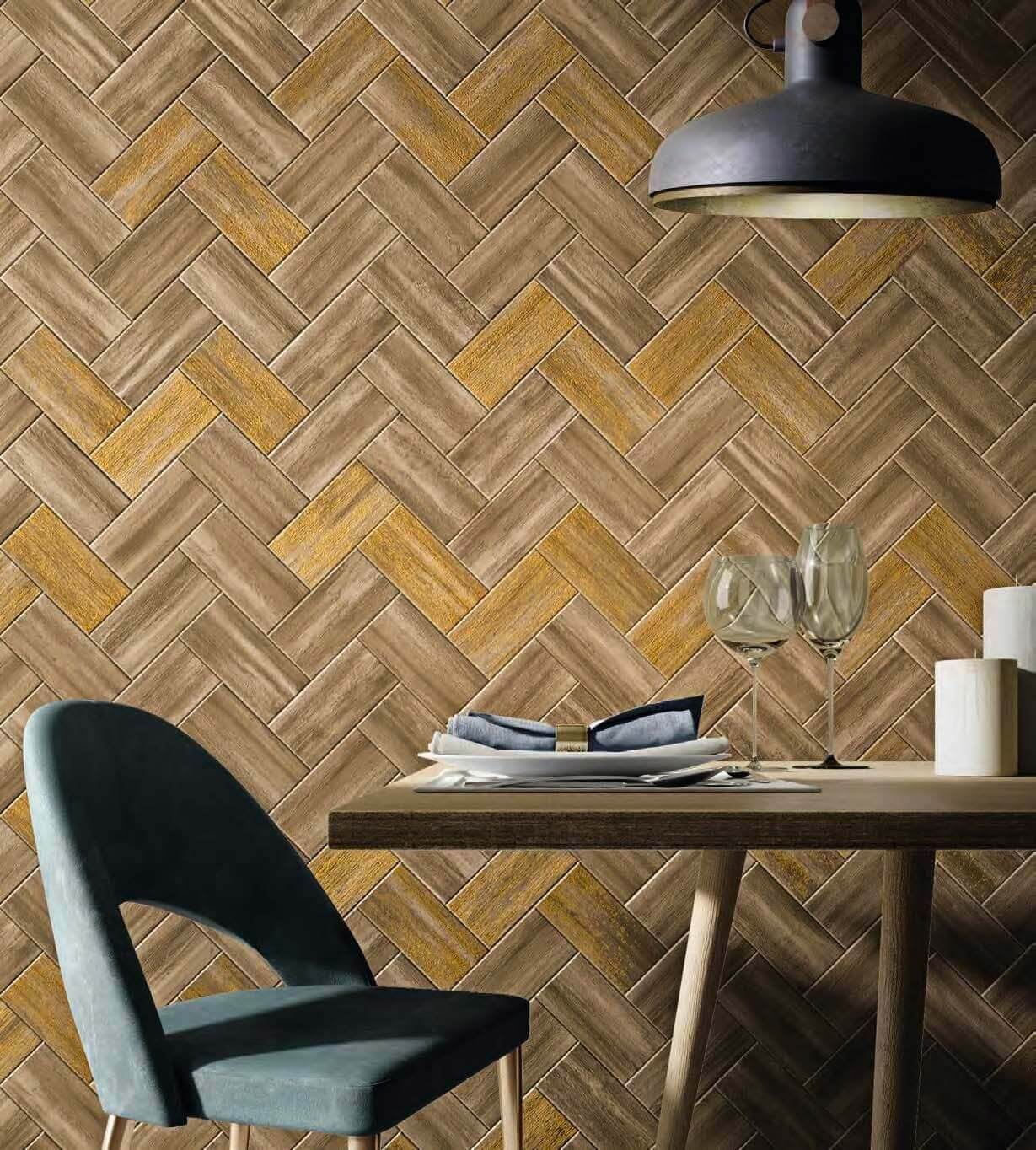
Whatever size you go with, tile makes for an impressive accent wall.
As with floor tile, there aren’t necessarily “standard” or “common” wall tile sizes. The size depends on what look you’re trying to achieve and the wall area itself. Wall tile tends to be lighter in weight and is suitable for walls but may not be suitable for flooring (consult your tile professional).
For example, backsplash tile size tends to be on the smaller side. Mosaic tiles (measuring less than 9 inches squared) as well as subway tiles (typically measuring 3 by 6 inches) are popular for backsplashes and other small wall areas, such as shower walls and niches, fireplace surrounds, and kitchen island fronts.
Similarly, we often see people use larger options for walls. Gauged porcelain tile panels/slabs make up the largest wall tile size available, at 10 by 15 feet. These large-size wall tiles effectively create the look of wallpaper and natural stones without those materials’ maintenance or sustainability concerns.
Of course, we’ve seen some pretty stunning gauged porcelain backsplash tile and mosaic tile feature walls — so take this advice with a grain of salt!
Beyond Ceramic Tile Size
There you have it! Bigger isn’t necessarily better, but neither is smaller. When it comes to a standard size, tiles simply refuse to be boxed in!

